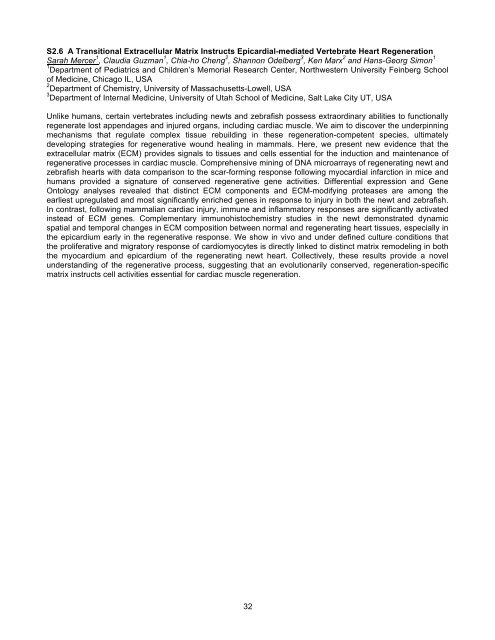Abstract Book Cover - Weinstein 2012 - University of Chicago
Abstract Book Cover - Weinstein 2012 - University of Chicago
Abstract Book Cover - Weinstein 2012 - University of Chicago
You also want an ePaper? Increase the reach of your titles
YUMPU automatically turns print PDFs into web optimized ePapers that Google loves.
S2.6 A Transitional Extracellular Matrix Instructs Epicardial-mediated Vertebrate Heart Regeneration<br />
Sarah Mercer 1 , Claudia Guzman 1 , Chia-ho Cheng 2 , Shannon Odelberg 3 , Ken Marx 2 and Hans-Georg Simon 1<br />
1<br />
Department <strong>of</strong> Pediatrics and Children’s Memorial Research Center, Northwestern <strong>University</strong> Feinberg School<br />
<strong>of</strong> Medicine, <strong>Chicago</strong> IL, USA<br />
2<br />
Department <strong>of</strong> Chemistry, <strong>University</strong> <strong>of</strong> Massachusetts-Lowell, USA<br />
3<br />
Department <strong>of</strong> Internal Medicine, <strong>University</strong> <strong>of</strong> Utah School <strong>of</strong> Medicine, Salt Lake City UT, USA<br />
Unlike humans, certain vertebrates including newts and zebrafish possess extraordinary abilities to functionally<br />
regenerate lost appendages and injured organs, including cardiac muscle. We aim to discover the underpinning<br />
mechanisms that regulate complex tissue rebuilding in these regeneration-competent species, ultimately<br />
developing strategies for regenerative wound healing in mammals. Here, we present new evidence that the<br />
extracellular matrix (ECM) provides signals to tissues and cells essential for the induction and maintenance <strong>of</strong><br />
regenerative processes in cardiac muscle. Comprehensive mining <strong>of</strong> DNA microarrays <strong>of</strong> regenerating newt and<br />
zebrafish hearts with data comparison to the scar-forming response following myocardial infarction in mice and<br />
humans provided a signature <strong>of</strong> conserved regenerative gene activities. Differential expression and Gene<br />
Ontology analyses revealed that distinct ECM components and ECM-modifying proteases are among the<br />
earliest upregulated and most significantly enriched genes in response to injury in both the newt and zebrafish.<br />
In contrast, following mammalian cardiac injury, immune and inflammatory responses are significantly activated<br />
instead <strong>of</strong> ECM genes. Complementary immunohistochemistry studies in the newt demonstrated dynamic<br />
spatial and temporal changes in ECM composition between normal and regenerating heart tissues, especially in<br />
the epicardium early in the regenerative response. We show in vivo and under defined culture conditions that<br />
the proliferative and migratory response <strong>of</strong> cardiomyocytes is directly linked to distinct matrix remodeling in both<br />
the myocardium and epicardium <strong>of</strong> the regenerating newt heart. Collectively, these results provide a novel<br />
understanding <strong>of</strong> the regenerative process, suggesting that an evolutionarily conserved, regeneration-specific<br />
matrix instructs cell activities essential for cardiac muscle regeneration.<br />
32


